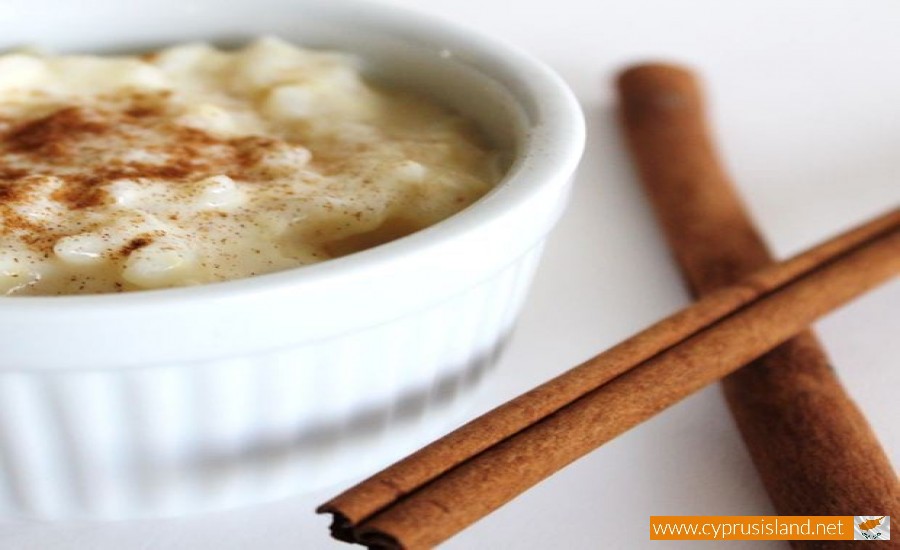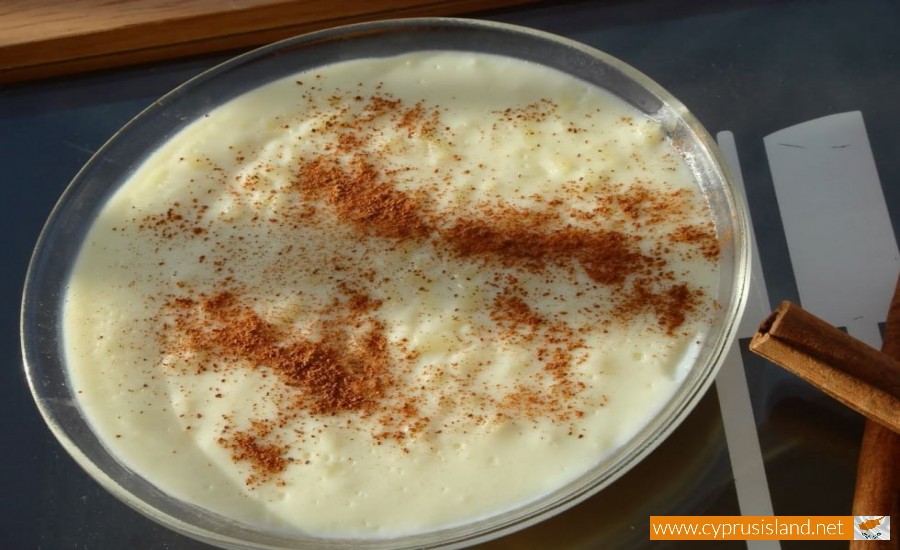Rizogalo (Rice pudding)
Simple, creamy, and steeped in tradition, rizogalo (Greek: ρυζόγαλο)—a blend of ryzi (rice) and gala (milk)—is one of Greece’s most beloved desserts. This classic rice pudding, served either warm or chilled, captures the essence of home cooking and culinary nostalgia across Greek and Cypriot kitchens. With every spoonful, rizogalo tells a story of family, seasons, and the gentle rhythm of the stovetop.
Though modest in its ingredients, rizogalo is rich in cultural meaning—served after Sunday meals, offered at festivals, or tucked into lunchboxes as a sweet surprise.
At its heart, rizogalo is a sweet rice pudding, made by simmering short-grain rice in milk and sugar until thickened into a creamy, silky consistency. It’s traditionally flavored with:
- Cinnamon (ground or stick)
- Vanilla (often added today)
- Sometimes lemon peel or orange zest
The most common topping? A generous dusting of ground cinnamon, which adds warmth and aroma to the dish.
Rizogalo can be served warm, especially in cooler months, or cold in glass cups—perfect for summer. Some enjoy it as a dessert, others as a sweet breakfast or snack.
Rizogalo has its roots in ancient and medieval culinary traditions, where rice and milk were valued for their soothing, nourishing qualities. Its closest relatives can be found in cuisines across the Mediterranean, Middle East, and South Asia—like Turkish sütlaç, Egyptian roz bel laban, and Indian kheer.
But the Greek and Cypriot version has carved out its own identity over time. With the rise of rice cultivation in Ottoman-influenced regions and the growing availability of dairy products, rizogalo became a rural staple—inexpensive, filling, and comforting.
In post-war Greece and Cyprus, it became a symbol of maternal cooking and village simplicity, prepared often without eggs or butter, making it accessible and even fasting-friendly during religious observances.
Ingredients and Traditional Preparation
Classic Rizogalo Ingredients:
- 1 cup short-grain or Arborio rice
- 4–5 cups whole milk (or a mix of milk and water)
- ½ cup sugar (adjust to taste)
- 1 cinnamon stick or ground cinnamon
- 1 tsp vanilla extract or a strip of lemon peel (optional)
- A pinch of salt
How It's Made:
- Boil the rice in water until it begins to soften.
- Add milk gradually, stirring constantly to avoid scorching.
- Simmer slowly, allowing the rice to absorb the milk and starches to thicken the pudding.
- Stir in sugar, vanilla, and any optional flavorings near the end.
- Once thick and creamy, spoon into bowls or glasses.
- Let it cool to room temperature or refrigerate.
- Sprinkle with cinnamon just before serving.
The result? A pudding that is soft yet slightly toothsome, rich yet delicate, and always deeply soothing.
In Cyprus, rizogalo is made almost identically to the Greek version, but with some regional preferences:
- Often prepared less sweet, relying more on the natural creaminess of milk.
- Some Cypriot home cooks use a bit of cornflour (cornstarch) for a smoother texture.
- It's commonly flavored with orange blossom water or citrus zest, especially in the villages.
- Local sheep’s milk or goat’s milk may be used in traditional households, adding richness.
In both urban and rural settings, Cypriot rizogalo remains a quiet star—served at family gatherings, religious feast days, or even handed out at school canteens.
Modern Variations and Serving Ideas
While traditional rizogalo needs no embellishment, modern cooks have found creative ways to evolve this classic:
- Coconut milk or almond milk for dairy-free versions
- Cardamom or mastic (mastiha) for exotic Eastern Mediterranean flair
- Toppings like toasted nuts, fruit compote, or honey
- A caramelized cinnamon sugar crust for a brûlée-style finish
Some upscale restaurants in Greece and Cyprus now serve rizogalo in elegant glass jars, paired with fresh berries or infused with saffron.
The Role of Rizogalo in Greek & Cypriot Culture
Rizogalo is one of those dishes that rarely appears on restaurant menus—but is deeply ingrained in home life. It evokes:
- Yiayia’s (grandmother’s) kitchen, where it would bubble slowly on the stove
- Post-dinner treats, when something light and sweet is needed
- Feast days and fasting periods, since it can be made without eggs or butter
- Childhood memories, often as a first dessert
It’s also common to see rizogalo offered at panigyria (village festivals), in tavernas with a family vibe, or sold by the cup at small zacharoplastia (pastry shops).
Nutrition and Simplicity
Rizogalo is surprisingly nutritious:
- Milk provides protein and calcium
- Rice offers carbs and warmth
- Low in fat when made traditionally (without eggs or cream)
- Can be gluten-free and vegetarian
It’s a dessert you can feel good about—nourishing, filling, and made with love.
Rizogalo is more than a dessert. It’s a culinary embrace—warm or chilled, simple or spiced, humble yet rich in meaning. In every home where it simmers, it speaks the language of tradition, care, and comfort.
So whether you find yourself enjoying rizogalo in a Cypriot village café, from a jar in a modern Athenian bistro, or lovingly made at home, know this: you’re tasting a dish that has soothed generations, one creamy spoonful at a time.











